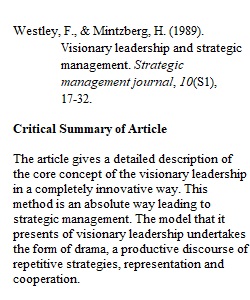


Q Annotated Bibliography 2 New Attempt • Due No Due Date • Points 30 • Submitting a file upload Due: Friday Module 2 To access the assignment instructions, click on the following document: Annotated Bibliography. Download Annotated Bibliography. ONLY use the articles below for your annotated bibliographies Select any two articles. Eisenhardt, K.M., Kahwajy, J.L., & Bourgeois lll, L. J. (1997). Conflict and strategic choice: How do top management teams disagree. California Management Review, 39(2) 42-62. Laine, P-M., & Vaara, E. (2007). Struggling over subjectivity: a discursive analysis of strategic development in an engineering firm. Human Relations, 60(1) 29-58. Raffaelli, R., Glynn, M A., & Tushman, M. (2019). Frame flexibility: The role of cognitive and emotional framing in innovation adoption by incumbent firms. Strategic Management Journal, 40 1013-1039 (Available at https://rdcu.be/bQYcY (Links to an external site.)) Westley, F. & Mintzberg, H. (1989). Visionary leadership and strategic management. Strategic Management Journal, 10, 17-32. You are only required to submit 2 annotations. To upload your completed work, click on the Start Assignment button and then the Submit Assignment button.
View Related Questions